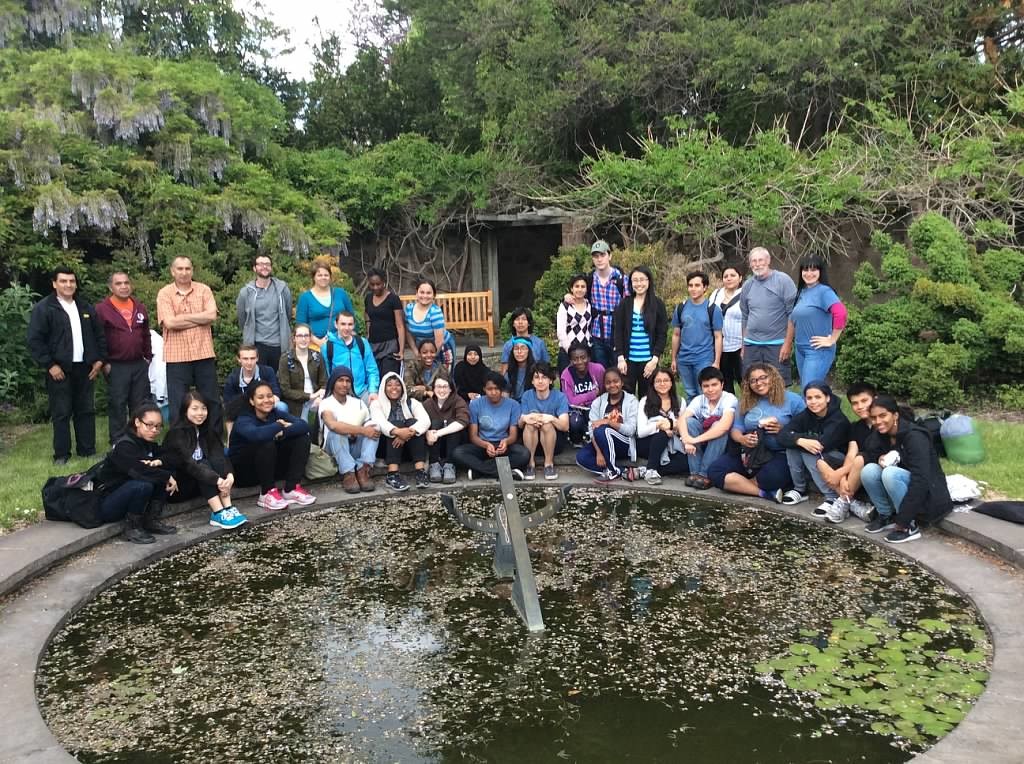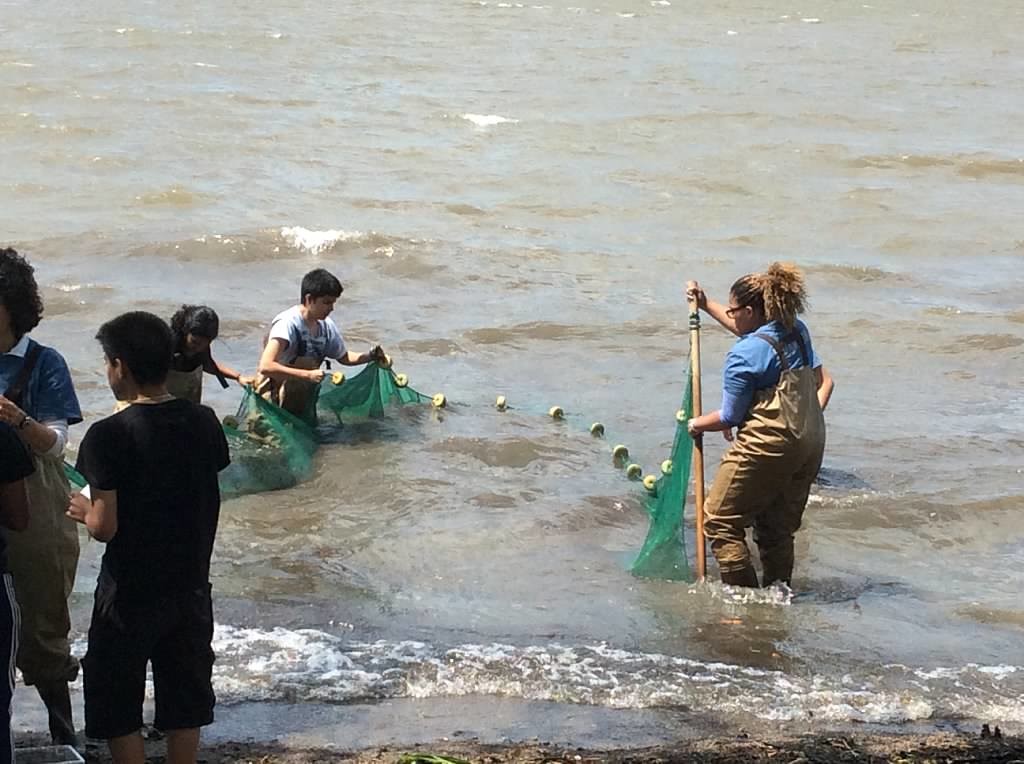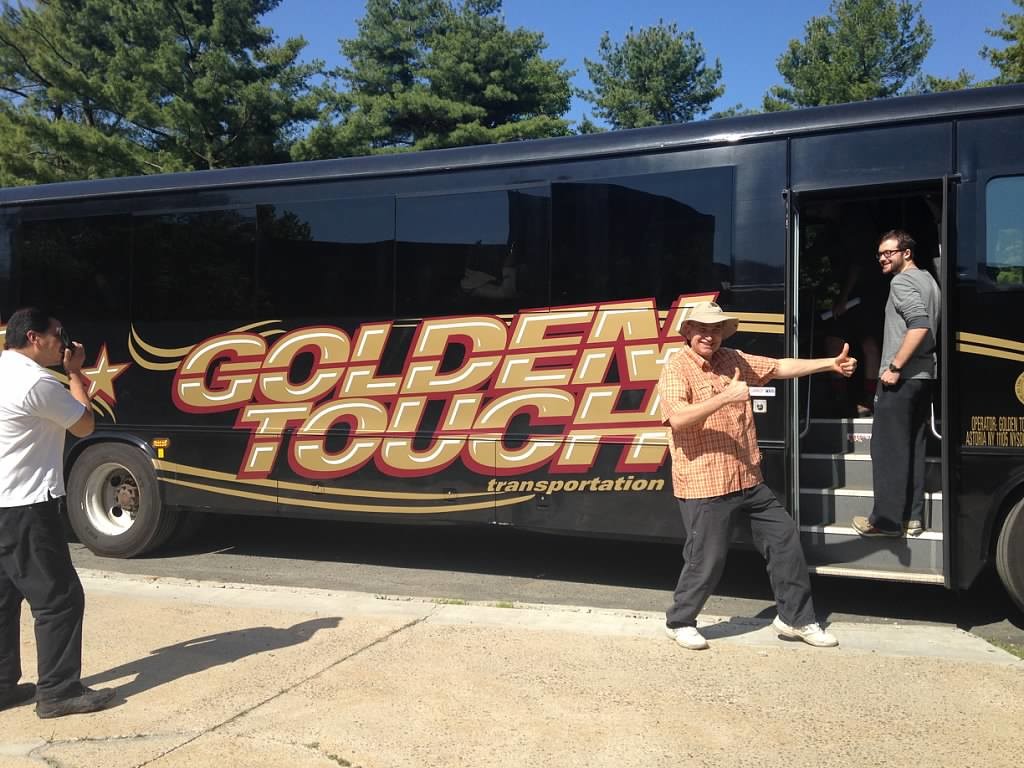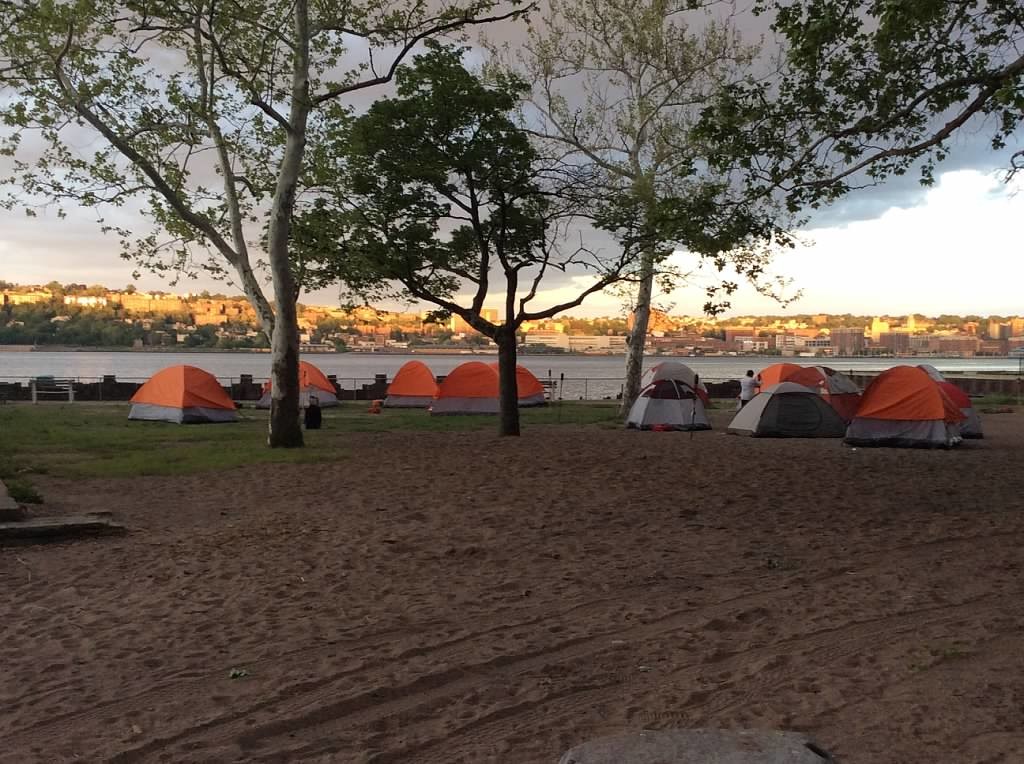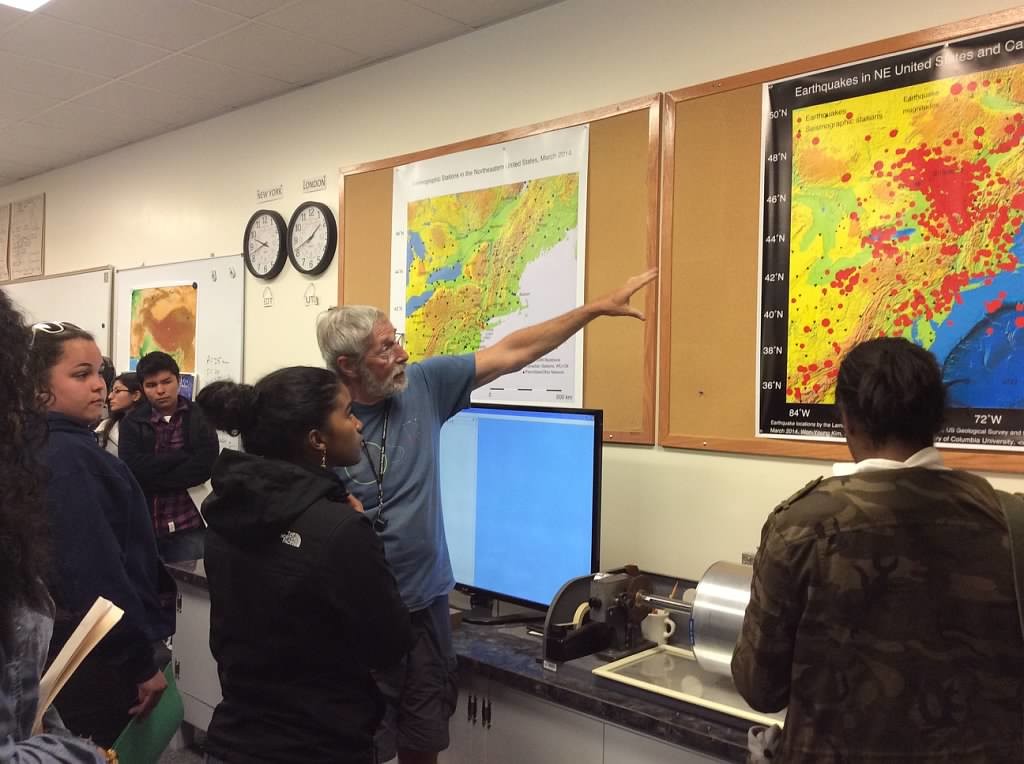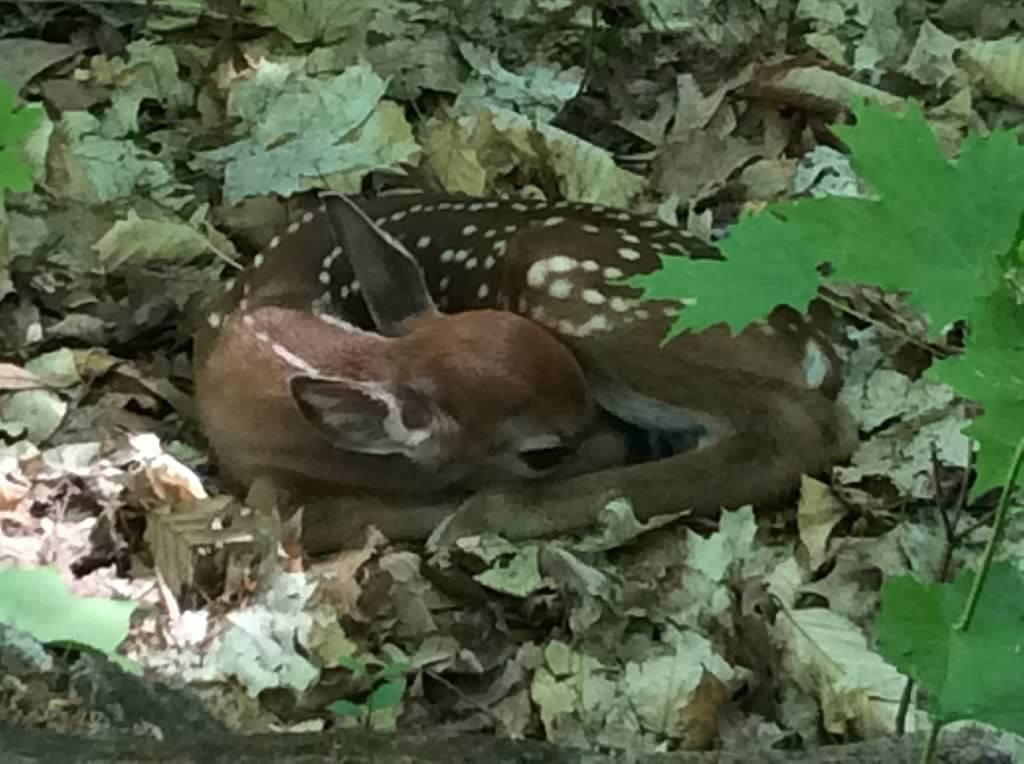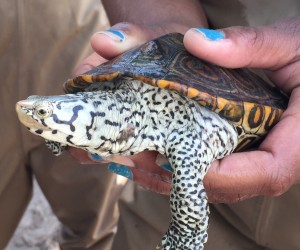By Vinzente Fedele
During the Memorial Day weekend, the Advanced Science Research program directed by Ms. Delarosa, Mr. Kenis, Mr. Hernandez, and Mr. Cherbow went on a field trip to the Lamont-Doherty Earth Observatory. Dr. Michael J. Passow, who works there as an Adjunct Associate Research Scientist in Marine Geology and Geophysics, guided our activities. He spoke about the science behind the ecosystem while giving us historical information as well. Unfortunately, I and some other students missed a lot of the field work during the earlier part of the day because we had to take the AP Biology exam. I arrived just as the group was ready to have a barbeque dinner.
Before I came, students spent the day taking plenty of samples for various tests. Using a technique called “coring,” the students took samples from the Earth and observed what elements they contained. Afterwards, they tested the turbidity, salinity, temperature, pH, and alkalinity of the Hudson River’s water. They also looked for the amount of nitrates present in the water. In addition, they checked the air temperature and wind force.
Later that afternoon they went “seine netting,” which is when people use some sort of drag net to catch fish or anything else in the water which might get caught. During this trip they netted a turtle known as a “diamondback terrapin” and two menhaden fish. They also participated in a discussion about how sea levels have risen within the past one hundred years and how scientists predict that sea levels will rise within the next one hundred years. After the educational activities and the barbeque, it was time to set up camp.
Before leaving the property where we ate, Michael Passow gathered us together and pointed to some plants near a garden wall. It was poison ivy! After giving everyone this heads-up, he led us to a sundial placed at the center of a small pond. The pond was surrounded by small, white flowers, and we were careful to not step on them. Michael spoke about the sundial and warned everyone not to attempt walking to it. The water was deeper than it looked, and one could have easily been fooled. In fact, a former ASR student whom I don’t know once walked straight into the murky water.
After taking a final look at the sundial we walked to the parking lot where a black bus, oddly branded with the name “Golden Touch” written in orange and red, waited for us. The inside of the bus was considerably hot.
Once we reached our campsite, all of the tents, sleeping bags, chairs, and other things had to be unloaded. Each of us carried armfuls of equipment to a sandy, beach-like area. Conveniently, there were bathrooms and a water fountain nearby. We fixed up our tents, then gathered again to speak with Michael. He talked about the rock formations called “palisades” and made historical connections to the Battle of Fort Lee during the American Revolutionary War. He mentioned that all of the trees that now cover the rocks did not exist during the time of the battle because most trees were chopped down.
After giving us a little history lesson and discussing further plans for the trip, Michael reminded us to be responsible in having fun. If I recall correctly, he said that he’d give us the same advice that his father had given to him. “Shut up!” he said. He then dispersed us to our leisure time, and I decided to skip rocks along the water. Looking at a deep line in the sand, Michael said quizzically to one of the students, “Do you know what that line is?” Even I became a little curious. “That’s where I dragged my boat this morning!” he said with a smile. He had the kind of humor which hides beneath the professional context of his words, so it wasn’t easy to anticipate his jokes.
For the remainder of that evening, students and teachers freely spoke to each other. We roasted marshmallows over a fire and made “s’mores” with Hershey’s chocolate and graham crackers. I spent much of the time lying on grass, and it was probably my first time having such an experience. I described the feeling as like lying on a “cuddly Christmas Tree.” I stared at the sky and relaxed in the cool, moist blades. Eventually we had to move into our tents where some of the students continued listening to music and talking.
I woke up around 5:00 AM, when the sun was still below the cliffs in the distance. I noticed that a roof cover on one of the tents had been blown off. There had been a wind storm overnight, and nearly everyone had believed that the tents would collapse. I was a little surprised because I couldn’t recall the event. I either slept through it or completely forgot. The morning was extremely cold, but I decided to sit on a wooden picnic table and wait for the sun to rise with another ASR student, Hannah George.
Soon the sun was up, and we broke camp. We carried our stuff back to the bus then went to one of Lamont Doherty’s buildings for breakfast. Michael talked more about the ecosystem, and he showed us their seismology room. He pointed to a computer screen where a map and icons illustrated every part of earth where an earthquake had occurred during different time periods, including recent earthquakes. Then we prepared for a hike, and I decided to use a walking stick just because I felt cool using one. While Michael’s walking stick was an actual tree branch, which looked like something that a hobbit from The Lord of the Rings might carry, everyone else received what looked like a broom or mop handle. Nevertheless, I was still satisfied and had fun. As we walked through the forest, Michael pointed to some of the fallen trees and explained how the carbon cycle was involved as the dead trees decomposed. We also came across a fawn, curled up and alone. Michael told us that it must have become separated from its mother.
Canoeing, our last activity, was the most exciting for me, and other students probably felt the same. Three or four people were placed in each canoe. Luckily, no one fell in the water which wasn’t very deep; however we were still required to wear life jackets. There were some moments when we bumped into each other’s canoes and rocks. The whole experience was unique. I felt my legs wobble as I stepped off the canoe onto a surface which didn’t oscillate as the canoe did.
Following the canoe trip, we ate lunch in the sun, on grass. Some people purchased ice cream from a place across the street. We were located in what seemed to be a small town with a number of art galleries. Michael gathered us together one last time and asked about our experiences. He also asked each of us what we would want to do if we had the chance to conduct our own field research. We thanked Michael for everything before boarding the Golden Touch again. We made our way back to Manhattan Center where we carried our supplies to the ASR room before going home.
Accompanying us on our camping trip were three visiting students from the Netherlands Their names were Sebastiaan Deij, Vonne Vleer, and Lucas Weber. Helen Steenbergen, a biology teacher from their school, came along as well. They arrived to the Lamont -Doherty site around the same time as I and the other late ASR students did. Sebastiaan and Vonne are fifteen while Lucas is sixteen. All of them are high school seniors back home. I decided to interview them and include some of what they had to say in this story. We spoke on the day of the 16th Annual June Symposium, a special event during which ASR students present studies researched independently.
This interview was my first experience of actually getting to know them since we hadn’t spoken during the camping trip. I was curious to ask all sorts of questions about their impressions of New York and of the field trip. I tried my best to jot down some fragments of their responses as we talked. When asked what they thought of New York and how it compared with the Netherlands, the visiting students had mostly favorable impressions. “I like this school,” Sebastiaan admitted. “It’s very nice,” added Vonne. Lucas was particularly impressed by some of our local food options as compared to Holland. “The food is way better,” Lucas commented, particularly pleased about getting “free refills” on drinks. Vonne and Sebastiaan are also big fans of the famous McDonald’s dessert known as the “McFlurry.”
Discussing fast food allowed me to recall someone mentioning that grocery stores in the UK contained products of smaller sizes, and I wondered if the same thing applied to the Netherlands, meaning that you wouldn’t find things like “family sized” boxes of cornflakes. Vonne pointed out that they did have family size Nutella but that in general smaller stores in smaller countries were used to having smaller sized products on their shelves. According to Vonne, their larger supermarkets also tended to be smaller than the ones in the United States. This part of our discussion reminded me of how much consumerism takes place in our country.
I asked if any of them had ever been to the United States before. All except Vonne were new to this country. She mentioned that she had previously traveled to Boston and Philadelphia. She also mentioned Washington, but I wasn’t sure if she meant Washington state or Washington D.C. since her description and hand gestures made the various locations sound as if they were all near each other.
“What did you think of the ASR camping trip?” I asked. Sebastiaan said he most enjoyed the camping and canoeing, but both he and Lucas found the ASR students nice and thought whole trip was fun. Vonne liked canoeing the best. When asked their overall impressions of New York, all three Dutch students admitted to being surprised by the size and density of New York. Their teacher Helen even remarked, “The amount of people in New York is like the amount of people in our whole country!” They visited many of New York’s famous landmarks, including the Brooklyn Bridge and Central Park. One of the students also mentioned something that might have been referring to the Solomon R. Guggenheim Museum, and I know that they also visited the American Museum of Natural History along with some ASR students on Memorial Day.
As one part of their New York experience, each of the Dutch students followed one ASR student for an entire school day. Asked how attending classes at MCSM compared with a day at their own school, the Dutch trio revealed some specific differences. Vonne said that gym class in the Netherlands was somewhat less “goal oriented” than P.E. at MCSM. For example they don’t do warm ups before the main exercises, and Vonne confessed “We don’t really know what we’re doing.” Her response made me recall many times in my middle school when I received little to no instruction on the class activities in gym.
The Dutch high school also seemed organized around smaller, more unified student cohorts for each grade. “We go to different classes, but we stay with the same people,” Vonne said about a typical school day back home. She explained that each class does have a different teacher, which for me and you, the reader, is easy to infer, but I wanted to make sure that I had a clear idea of what she meant. “I’m with them all day long,” she said, gesturing to Lucas and Sebastiaan. She also said that their normal school day “… stops really early, but it also begins really early.” Lucas added, “We have no security.” Then his classmates went into detail about how when entering their school one simply doesn’t experience the same commotion of swiping ID cards and patrolling security guards.
Sadly, our Dutch visitors were not able to stay for the symposium because their flight was scheduled to leave early. Although they felt bad about missing the symposium, Lucas at least was beginning to feel homesick and missed his mom. Their teacher Helen regretted than the person in Holland who booked their plane tickets didn’t realize how much they had been scheduled to do here, and cut their travel schedule too short on both ends of their trip. “We missed the field work, and [now] we’re missing the symposium,” said Helen. Nevertheless, despite their early departure, the students managed to film a poster board presentation based on their research, and the video was later shown at the symposium.
As we approached the end of our conversation, I asked about their plans for the rest of the summer. “I’m going to Italy and Greece,” said Sebastiaan. Vonne told me she was going to Spain, and Lucas said that he was going on holiday with his friends. When I asked Helen if she had plans, she said, “Not yet… thinking about going to Croatia… might be last minute.” I was surprised by their plans and mentioned that I never left this country. Helen reminded me that since many European countries are connected by land, it’s much easier to travel between them. One can simply drive to neighboring countries.
Lastly, I asked about their hobbies. Sebastiaan said that he enjoyed playing the piano and “tracking,” a term which I didn’t fully understand. Vonne said she also plays the piano, and her other activities include reading, watching movies, and drawing. Lucas practices Hapkido martial arts. Helen said that she has no hobbies. After I shared my extracurricular interests and hobbies, we said our final goodbyes. I was finally back on my way to class while they were planning to head across the street for some last minute shopping at Target, a famous local discount store they had yet to explore.
